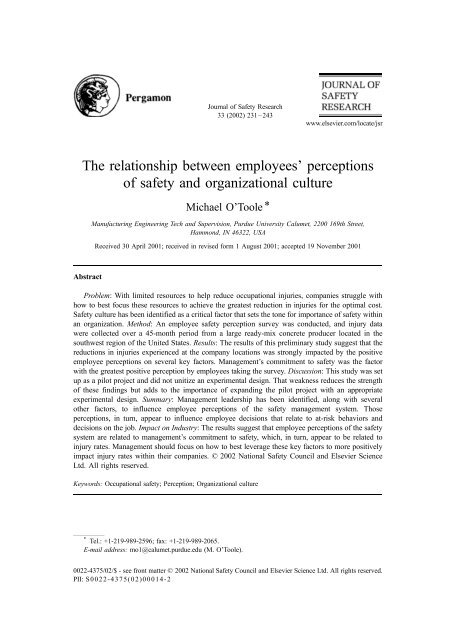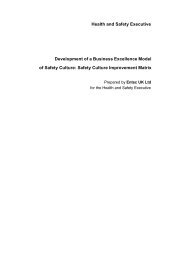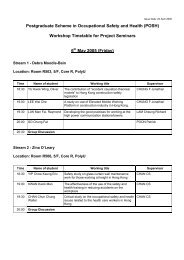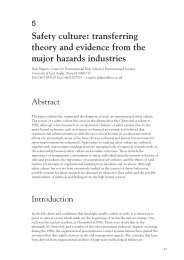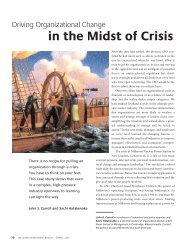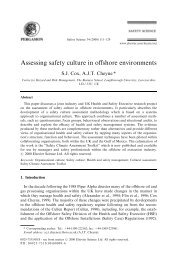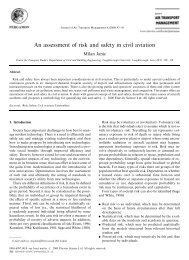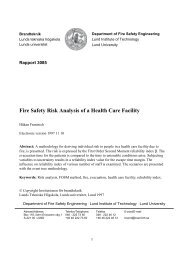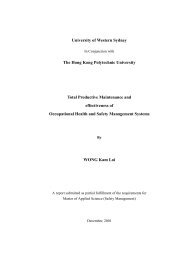The relationship between employees' perceptions of safety and ...
The relationship between employees' perceptions of safety and ...
The relationship between employees' perceptions of safety and ...
Create successful ePaper yourself
Turn your PDF publications into a flip-book with our unique Google optimized e-Paper software.
Journal <strong>of</strong> Safety Research<br />
33 (2002) 231–243<br />
www.elsevier.com/locate/jsr<br />
<strong>The</strong> <strong>relationship</strong> <strong>between</strong> employees’ <strong>perceptions</strong><br />
<strong>of</strong> <strong>safety</strong> <strong>and</strong> organizational culture<br />
Michael O’Toole *<br />
Manufacturing Engineering Tech <strong>and</strong> Supervision, Purdue University Calumet, 2200 169th Street,<br />
Hammond, IN 46322, USA<br />
Received 30 April 2001; received in revised form 1 August 2001; accepted 19 November 2001<br />
Abstract<br />
Problem: With limited resources to help reduce occupational injuries, companies struggle with<br />
how to best focus these resources to achieve the greatest reduction in injuries for the optimal cost.<br />
Safety culture has been identified as a critical factor that sets the tone for importance <strong>of</strong> <strong>safety</strong> within<br />
an organization. Method: An employee <strong>safety</strong> perception survey was conducted, <strong>and</strong> injury data<br />
were collected over a 45-month period from a large ready-mix concrete producer located in the<br />
southwest region <strong>of</strong> the United States. Results: <strong>The</strong> results <strong>of</strong> this preliminary study suggest that the<br />
reductions in injuries experienced at the company locations was strongly impacted by the positive<br />
employee <strong>perceptions</strong> on several key factors. Management’s commitment to <strong>safety</strong> was the factor<br />
with the greatest positive perception by employees taking the survey. Discussion: This study was set<br />
up as a pilot project <strong>and</strong> did not unitize an experimental design. That weakness reduces the strength<br />
<strong>of</strong> these findings but adds to the importance <strong>of</strong> exp<strong>and</strong>ing the pilot project with an appropriate<br />
experimental design. Summary: Management leadership has been identified, along with several<br />
other factors, to influence employee <strong>perceptions</strong> <strong>of</strong> the <strong>safety</strong> management system. Those<br />
<strong>perceptions</strong>, in turn, appear to influence employee decisions that relate to at-risk behaviors <strong>and</strong><br />
decisions on the job. Impact on Industry: <strong>The</strong> results suggest that employee <strong>perceptions</strong> <strong>of</strong> the <strong>safety</strong><br />
system are related to management’s commitment to <strong>safety</strong>, which, in turn, appear to be related to<br />
injury rates. Management should focus on how to best leverage these key factors to more positively<br />
impact injury rates within their companies. D 2002 National Safety Council <strong>and</strong> Elsevier Science<br />
Ltd. All rights reserved.<br />
Keywords: Occupational <strong>safety</strong>; Perception; Organizational culture<br />
* Tel.: +1-219-989-2596; fax: +1-219-989-2065.<br />
E-mail address: mo1@calumet.purdue.edu (M. O’Toole).<br />
0022-4375/02/$ - see front matter D 2002 National Safety Council <strong>and</strong> Elsevier Science Ltd. All rights reserved.<br />
PII: S0022-4375(02)00014-2
232<br />
M. O’Toole / Journal <strong>of</strong> Safety Research 33 (2002) 231–243<br />
1. Introduction<br />
During 1998, more than 9 out <strong>of</strong> 100 workers in the manufacturing sector experienced<br />
an injury at work that required medical attention (National Safety Council [NSC], 1999).<br />
According to NSC, accidents <strong>and</strong> their consequences continue to be a major public health<br />
concern. Those in the industry have historically focused efforts on reducing injuries<br />
through engineering controls <strong>and</strong> attending to physical conditions <strong>of</strong> the work environment.<br />
Although critically important, many <strong>safety</strong> pr<strong>of</strong>essionals recognize that there are<br />
other factors that significantly influence the likelihood <strong>of</strong> injury to employees.<br />
This study was developed with the following objectives in mind:<br />
<br />
<br />
<br />
<br />
To examine the use <strong>of</strong> an employee perception survey as a predictive tool <strong>of</strong><br />
successful <strong>safety</strong> results;<br />
To identify factors that, when present, suggest a high level <strong>of</strong> risk-control<br />
effectiveness;<br />
To examine the use <strong>of</strong> an employee perception survey as an alternative measure <strong>of</strong><br />
an effective <strong>and</strong> successful <strong>safety</strong> program; <strong>and</strong><br />
To identify general factors that influence employee <strong>perceptions</strong> <strong>of</strong> a company’s<br />
supervisory/management <strong>safety</strong> process.<br />
<strong>The</strong> fundamental management process is to allocate available resources to a<br />
productive end. <strong>The</strong> limited resources that managers have to work with are those <strong>of</strong><br />
time, money, <strong>and</strong> people. One responsibility <strong>of</strong> most managers is the <strong>safety</strong> <strong>and</strong> health <strong>of</strong><br />
those employees under their direction. From a practical point <strong>of</strong> view, management<br />
needs to identify how to best allocate resources to ensure the lowest possible number<br />
<strong>and</strong> severity <strong>of</strong> injuries experienced by employees. In order to conserve resources,<br />
managers have to be aware <strong>of</strong> what resources they do commit to <strong>safety</strong> <strong>and</strong> how those<br />
resources influence the number <strong>and</strong> severity <strong>of</strong> injuries experienced by their employees.<br />
Traditional <strong>safety</strong> management efforts have run the gamut from the inspection era, the<br />
OSHA era, to the Accountability <strong>and</strong> the Human era (Petersen, 1988). More recent data<br />
suggest that it is the management system that has the most significant impact on injury<br />
rates (Petersen, 2000). Efforts that focus on several key management processes such as<br />
OSHA’s Voluntary Protection Plan have demonstrated that systematic management <strong>of</strong><br />
<strong>safety</strong> <strong>and</strong> health processes result in lower injury rates <strong>and</strong> usually higher productivity.<br />
O’Toole (1999), in a study <strong>of</strong> employee participation at eight manufacturing sites, found<br />
that merely providing <strong>and</strong> encouraging employees to participate in the <strong>safety</strong> process<br />
resulted in lower incidence <strong>of</strong> OSHA Lost Time Injuries <strong>and</strong> lower severity rates over<br />
time.<br />
2. About the study<br />
This study was conducted using a modified version <strong>of</strong> the Minnesota Perception<br />
Survey, which was originally developed by Bailey <strong>and</strong> Peterson for the railroad industry.<br />
<strong>The</strong> survey used in this project was developed <strong>and</strong> validated by Dr. Brooks Carder for use
M. O’Toole / Journal <strong>of</strong> Safety Research 33 (2002) 231–243 233<br />
in a number <strong>of</strong> different manufacturing industries. <strong>The</strong> subject company is a mining <strong>and</strong><br />
construction products company headquartered in Houston, TX. Like many others, this<br />
company struggles with its <strong>safety</strong> efforts <strong>and</strong> uses OSHA, MSHA, <strong>and</strong> the DOT<br />
compliance as the engines that drive the <strong>safety</strong> program.<br />
In March 1998, upper management initiated a number <strong>of</strong> changes to their traditional<br />
approach to <strong>safety</strong>. <strong>The</strong> management team established a goal to shift the company’s<br />
<strong>safety</strong> culture from one driven by compliance to one driven by doing the right thing to<br />
prevent accidents <strong>and</strong> injuries to employees. Management’s aim was to include <strong>safety</strong><br />
as a company core value, one that every manager <strong>and</strong> supervisor was expected to<br />
embrace. A key focus <strong>of</strong> this new emphasis on <strong>safety</strong> was management’s accountability<br />
for <strong>safety</strong> <strong>and</strong> their commitment to demonstrating their leadership <strong>and</strong> support for<br />
<strong>safety</strong>.<br />
By mid-1988, a series <strong>of</strong> educational sessions were conducted for managers <strong>and</strong><br />
supervisors to provide them with insights into leadership techniques <strong>and</strong> to develop their<br />
interpersonal communication skills. Those sessions were conducted over a 14-month<br />
period <strong>and</strong> included all production managers. <strong>The</strong>se managers were then held accountable,<br />
as part <strong>of</strong> their performance review, for developing <strong>and</strong> implementing specific leadership<br />
techniques as they relate to <strong>safety</strong>. Approaches such as behavior modeling, positive<br />
feedback, <strong>and</strong> actively seeking employee input <strong>and</strong> involvement were areas identified for<br />
action.<br />
<strong>The</strong> company recognized that employees’ attitudes <strong>and</strong> <strong>perceptions</strong> help to drive<br />
behavior, so the training <strong>and</strong> educational sessions were focused to influence those attitudes<br />
<strong>and</strong> <strong>perceptions</strong>. At the conclusion <strong>of</strong> each session, the participants were assigned three<br />
objectives. <strong>The</strong> first objective was to be aware <strong>of</strong> the example that they set for their<br />
employees. <strong>The</strong> participant was to be able to report to their superior a different example <strong>of</strong><br />
how they set the correct <strong>safety</strong> example. <strong>The</strong> second objective required each supervisor<br />
<strong>and</strong> manager to provide, on a weekly basis, positive feedback to an employee about a<br />
specific <strong>safety</strong> issue or procedure that was observed. <strong>The</strong> third objective addressed another<br />
factor felt to be critical to changing the <strong>safety</strong> culture, that <strong>of</strong> employee participation in the<br />
<strong>safety</strong> process. After completing the training sessions, the participants were to engage their<br />
employees in a Job Safety Analysis (JSA) process. One JSA was to be completed by each<br />
supervisor <strong>and</strong> manager each month.<br />
As part <strong>of</strong> the company’s long-range plan, an Employee Safety Perception survey was<br />
presented to all employees during January 2000. It was felt that a perception survey could<br />
add information about the <strong>safety</strong> management system from the perspective <strong>of</strong> employees at<br />
all levels. In addition, management believed that it needed a benchmark against which to<br />
measure future improvements to the system. If changes to the management system actually<br />
impact injury rates, then it is logical to conclude that it should positively impact the way<br />
employees perceive management <strong>and</strong> its commitment to <strong>safety</strong>. In other words, will<br />
employees perceive managers as ‘‘walking the talk’’ <strong>of</strong> <strong>safety</strong> leadership?<br />
Additionally, the subject company’s management intends to conduct a follow-up<br />
survey in 3 years to measure progress against the baseline survey results. Prior to this<br />
future survey, a quasi-experimental design will be employed to allow for inferential data<br />
analysis <strong>and</strong> to control for various biases that can influence the results (Campbell &<br />
Stanley, 1966).
234<br />
M. O’Toole / Journal <strong>of</strong> Safety Research 33 (2002) 231–243<br />
3. Literature review<br />
<strong>The</strong> American Heritage Dictionary defines ‘‘culture’’ as ‘‘the totality <strong>of</strong> socially<br />
transmitted behavior patterns, arts, beliefs, institutions, <strong>and</strong> all other products <strong>of</strong> human<br />
work <strong>and</strong> thought characteristic <strong>of</strong> a community or population.’’ More specifically then,<br />
corporate culture is a pattern <strong>of</strong> beliefs <strong>and</strong> assumptions shared by members <strong>of</strong> the<br />
organization that operates unconsciously <strong>and</strong> that defines in a basic, taken-for-granted<br />
fashion an organization’s view <strong>of</strong> itself <strong>and</strong> its environment (Schein, 1986). Safety culture<br />
is <strong>of</strong>ten seen as a subset <strong>of</strong> organizational culture, where the beliefs <strong>and</strong> values refer<br />
specifically to matters <strong>of</strong> health <strong>and</strong> <strong>safety</strong> (Clarke, 1999).<br />
One way to make the <strong>safety</strong> culture more visible is through the use <strong>of</strong> employee<br />
perception surveys, which have been valuable tools for detecting differences in employee<br />
attitudes concerning several management practices. <strong>The</strong>se tools have also been applied to<br />
the <strong>safety</strong> field for measuring <strong>safety</strong> program effectiveness. In an early study, Zohar (1980)<br />
used an employee questionnaire to identify the relative importance <strong>of</strong> specific <strong>safety</strong><br />
factors in 20 industrial organizations in Israel.<br />
In another study, Bailey (1989) used the Minnesota Safety Perception Survey to<br />
identify factors that positively contributed to injury reduction within the railroad industry.<br />
Both the original study <strong>and</strong> its ongoing follow-up, which include other industries (Bailey,<br />
1997), showed that in plants that had low injury rates, the employees’ perception <strong>of</strong><br />
management commitment to <strong>safety</strong> was highly positive. On the other h<strong>and</strong>, in plants where<br />
injury rates were high, the employees’ perception <strong>of</strong> management commitment to <strong>safety</strong><br />
was low <strong>and</strong> the major focus <strong>of</strong> management’s <strong>safety</strong> efforts was on OSHA compliance<br />
with limited employee involvement practices.<br />
Employees’ <strong>perceptions</strong> <strong>of</strong> management’s commitment to <strong>safety</strong>, <strong>of</strong> fellow employees’<br />
participation in <strong>safety</strong>, <strong>and</strong> <strong>of</strong> the effectiveness <strong>of</strong> education <strong>and</strong> training efforts on the part<br />
<strong>of</strong> management have demonstrated a positive impact on <strong>safety</strong> outcomes. <strong>The</strong> literature<br />
suggests that employees’ <strong>perceptions</strong> <strong>of</strong> these factors influence their likelihood to comply<br />
with <strong>safety</strong> <strong>and</strong> health policies <strong>and</strong> rules (Bailey, 1997).<br />
Simonds <strong>and</strong> Shafari-Sahrai (1977) analyzed the <strong>relationship</strong> <strong>between</strong> injury frequency<br />
rates <strong>and</strong> factors thought to influence injury rates, such as management involvement in the<br />
<strong>safety</strong> effort, workforce characteristics, <strong>and</strong> physical conditions. <strong>The</strong>y gathered data on the<br />
management system <strong>of</strong> companies, some with high injury rates <strong>and</strong> others with low injury<br />
rates. In studying these matched pairs <strong>of</strong> companies, the researchers found that in companies<br />
where top management is involved in <strong>safety</strong>, there were lower injury frequency rates.<br />
In a similar study, Cohen (1977) examined critical determinants <strong>of</strong> a successful<br />
industrial <strong>safety</strong> program. Cohen found that at firms determined to have successful <strong>safety</strong><br />
programs (i.e., firms that experienced low injury rates), certain common factors were<br />
present, including a strong management commitment to <strong>safety</strong> as reflected by management’s<br />
knowledge <strong>of</strong> the problems, their convictions that high <strong>safety</strong> st<strong>and</strong>ards were<br />
attainable <strong>and</strong> their demonstrated work toward those ends. In addition, Cohen identified<br />
extensive formal <strong>and</strong> informal contacts <strong>between</strong> workers <strong>and</strong> management on <strong>safety</strong> issues<br />
<strong>and</strong> a well-established <strong>safety</strong> training process as factors contributing to low accident rates.<br />
In a follow-up study, Smith, Cohen, Cohen, & Clevel<strong>and</strong> (1978), found that management’s<br />
commitment to the <strong>safety</strong> process was an important factor at low injury rate plants.
M. O’Toole / Journal <strong>of</strong> Safety Research 33 (2002) 231–243 235<br />
In the past, industry has concentrated its efforts on reducing injuries by focusing on<br />
physical conditions such as the guarding <strong>of</strong> equipment or other factors that exposed<br />
employees to energy sources (Heinrich, 1959; Kohn, Friend, & Winterberger, 1996).<br />
Industry has also focused on addressing primarily those issues that OSHA regulates <strong>and</strong> is<br />
likely to check during an inspection at a facility (Smith, 1979; Weil, 1994).<br />
OSHA, in turn, has traditionally emphasized engineering controls <strong>and</strong> prescriptive<br />
regulations as solutions to the problem <strong>of</strong> reducing hazards in the workplace. Historically,<br />
OSHA has relied on a coercive approach through the use <strong>of</strong> citations <strong>and</strong> fines to motivate<br />
employers to comply with the regulations (Goetsch, 1996). However, in a speech to the<br />
Illinois Safety Council, Charles Jeffers (1998), Assistant Secretary <strong>of</strong> Labor, reported that<br />
OSHA has attempted to shift <strong>and</strong> improve its role through expansion <strong>of</strong> consultation<br />
programs <strong>and</strong> initiatives, such as the Voluntary Protection Program (VPP) <strong>and</strong> the<br />
previously launched Cooperative Compliance Program (CCP).<br />
This literature suggests that there is a connection <strong>between</strong> management’s approach to<br />
<strong>safety</strong>, the employees’ perception <strong>of</strong> management, <strong>and</strong> accident/injury rates. In addition, it<br />
has been suggested that management’s commitment <strong>and</strong> leadership with <strong>safety</strong> issues is a<br />
significant determinant in obtaining necessary employee commitment to <strong>safety</strong>. This study<br />
is an attempt to exp<strong>and</strong> our underst<strong>and</strong>ing <strong>of</strong> that connection.<br />
4. <strong>The</strong>oretical assumptions<br />
<strong>The</strong> findings <strong>of</strong> this observational study are based on a comparison <strong>of</strong> data from written<br />
surveys <strong>and</strong> several in-person interviews. Several key theoretical principles have been<br />
applied to the findings.<br />
(1) Accidents are defects in the system <strong>and</strong> are not simply a result <strong>of</strong> the carelessness or<br />
errors <strong>of</strong> individuals. To reduce these defects, the system must be analyzed to discover<br />
areas for improvement.<br />
(2) <strong>The</strong> attitudes <strong>and</strong> <strong>perceptions</strong> <strong>of</strong> the employees reveal the vision <strong>and</strong> values that<br />
drive their decision-making process. Management’s ability to communicate positive values<br />
<strong>and</strong> expectations is critical to ensuring that workers will make their decisions with <strong>safety</strong><br />
as a proper priority.<br />
(3) Building an ‘‘improvement culture’’ requires a commitment to learning <strong>and</strong> change.<br />
<strong>The</strong>se are most likely to happen in an environment where fear is minimized. A positive<br />
climate is created by recognizing those employees who actively attempt to contribute to<br />
improving the work processes to reduce the likelihood <strong>of</strong> accidents. A positive <strong>safety</strong><br />
climate is supported by:<br />
(a) treating accident incidents as system problems, not opportunities to fix blame <strong>and</strong><br />
(b) treating employees as thinking, knowledgeable, <strong>and</strong> important players whose<br />
opinions <strong>and</strong> suggestions are solicited <strong>and</strong> frequently acted upon.<br />
(4) In any complex system, there exist leverage points. <strong>The</strong>se are areas in which<br />
changing the system will yield maximum changes in system performance. <strong>The</strong> objective <strong>of</strong><br />
this assessment is to help management identify these leverage points.
236<br />
M. O’Toole / Journal <strong>of</strong> Safety Research 33 (2002) 231–243<br />
(5) It is understood that all parts <strong>of</strong> a system are interrelated; however, findings from<br />
this assessment are limited to the <strong>safety</strong> system.<br />
5. Methods<br />
A 41-item <strong>safety</strong> perception survey was distributed to all employees, including plant<br />
<strong>of</strong>fice employees. Each item presented the employee with a choice <strong>of</strong> responding either<br />
‘‘yes’’ or ‘‘no.’’ From the combined responses, a percent positive response rate was<br />
computed for each question by dividing the total number <strong>of</strong> positive responses by the total<br />
responses. It consists <strong>of</strong> those questions <strong>and</strong> factors that prior research has shown to be<br />
valid indicators <strong>of</strong> the state <strong>of</strong> the management system. <strong>The</strong> results are compared to<br />
normative data from previously administered surveys from other industrial companies,<br />
which are contained in a database <strong>of</strong> more than 50,000 surveys.<br />
Once aggregated, the data can be examined at a number <strong>of</strong> different levels in an attempt<br />
to identify external factors that might influence the company’s <strong>safety</strong> results. From the<br />
demographic data, the following independent variables were examined for their potential<br />
influence on the <strong>safety</strong> results: (a) Location, (b) Business Group, (c) Job Categories, (d)<br />
Company Length <strong>of</strong> Service, <strong>and</strong> (e) Age.<br />
A total <strong>of</strong> 3116 surveys were distributed during <strong>safety</strong> meetings, where employees had<br />
an opportunity to complete the survey on a voluntary basis during work time. A total <strong>of</strong><br />
1414 surveys were returned, for a response rate <strong>of</strong> 45.3%. According to an expert at NSC,<br />
had the approach been followed as prescribed, a response rate <strong>of</strong> 80%–90% would have<br />
been expected (K. Kolosh, personal communication, February 6, 2001).<br />
After the survey was completed, the author had the opportunity to investigate the lowerthan-expected<br />
response rates at a number <strong>of</strong> the company’s locations. Information gathered<br />
as part <strong>of</strong> informal conversations with managers throughout the company suggest that<br />
some locations did not follow the instructions for distributing the survey as part <strong>of</strong> monthly<br />
<strong>safety</strong> meetings in January 1999. Apparently, at these locations, managers or supervisors<br />
h<strong>and</strong>ed the surveys out to employees at the beginning or end <strong>of</strong> a shift <strong>and</strong> requested that<br />
the employees fill them out <strong>and</strong> return them to the <strong>of</strong>fice. <strong>The</strong>re was little or no follow-up<br />
with employees who failed to return a completed survey. According to Kolosh, given those<br />
Table 1<br />
Percent survey response by company geographical locations<br />
Company locations Total surveys received Percent by location<br />
Dallas-Fort Worth/N. Texas 394 45.7<br />
Houston/S. Texas 349 49.6<br />
East <strong>and</strong> West Texas 147 33.6<br />
Phoenix 191 46.1<br />
Las Vegas 27 27.3<br />
Salt Lake City 90 28.7<br />
Arkansas 137 32.9<br />
San Diego 79 26.1<br />
Total 1414 45.3
M. O’Toole / Journal <strong>of</strong> Safety Research 33 (2002) 231–243 237<br />
circumstances, a response rate <strong>of</strong> 20%–30% would normally be expected. Although the<br />
response rate was lower than expected, there appears to be no systematic bias introduced,<br />
as the distribution phenomenon appeared to be somewhat r<strong>and</strong>om <strong>and</strong> uniform throughout<br />
the company. Most <strong>of</strong> the locations had a response rate that reflected the overall average<br />
response rate, with no locations below a 26% response rate or above a 50% response rate.<br />
Table 1 shows the percent response by company geographical groupings.<br />
6. Results<br />
To analyze the <strong>safety</strong> survey responses, the totals for each question were compared <strong>and</strong><br />
the percent <strong>of</strong> ‘‘positive’’ responses was computed. This was accomplished by simply<br />
adding the number <strong>of</strong> ‘‘yes’’ responses for each question <strong>and</strong> dividing by the total<br />
responses for that question. For example, Question 1 had a total <strong>of</strong> 1375 responses, <strong>of</strong><br />
which 1232 were positive (yes), to equal a 90.8% positive response rate for this question.<br />
Each <strong>of</strong> the questions on the survey has a positive answer, which indicates the existence <strong>of</strong><br />
some aspect <strong>of</strong> a good <strong>safety</strong> system. <strong>The</strong> positive answer on most, but not all questions, is<br />
‘‘yes.’’ <strong>The</strong> questions reflect different aspects <strong>of</strong> the management system.<br />
Extensive data sets are used to show these questions are ‘‘valid’’ measures <strong>of</strong> the <strong>safety</strong><br />
system. This means that sites or organizations with higher injury rates will have fewer<br />
positive scores on the survey questions.<br />
In order to better underst<strong>and</strong> the meaning <strong>of</strong> the results from this survey, a series <strong>of</strong><br />
factor analyses had been previously conducted on the data from the normative data set. A<br />
factor analysis is a statistical analysis designed to discover groups <strong>of</strong> questions that<br />
correlate with each other. <strong>The</strong> statistical analysis is combined with an analysis <strong>of</strong> question<br />
content to arrive at a set <strong>of</strong> factors. This survey was determined to measure seven factors.<br />
<strong>The</strong> factor analysis was conducted on two samples. <strong>The</strong> first was 6306 surveys received<br />
from one company in 1994. <strong>The</strong> second was a smaller number <strong>of</strong> cases from another<br />
company in the same year. <strong>The</strong> model was developed on the larger data set <strong>and</strong> then was<br />
tested on the smaller data set.<br />
<strong>The</strong> variance explained by the factors is shown in Table 2.<br />
Many questions load on more than one factor, but for simplicity, each question was<br />
allowed to represent the factor with the highest loading. Factor loadings for questions<br />
Table 2<br />
Percent variance explained<br />
Factor Name Percent <strong>of</strong> variance explained<br />
1 Management’s Commitment to Safety 11.94<br />
2 Education <strong>and</strong> Knowledge 5.62<br />
3 Safety Supervisory Process 9.72<br />
4 Employee Involvement <strong>and</strong> Commitment 5.48<br />
5 Drugs <strong>and</strong> Alcohol 3.04<br />
6 Emergency Response 7.59<br />
7 Off-the-Job Safety 3.89<br />
Total 47.26
238<br />
M. O’Toole / Journal <strong>of</strong> Safety Research 33 (2002) 231–243<br />
Table 3<br />
Factor loading for Factor 1<br />
Question number<br />
Factor loading<br />
5 .438<br />
8 .359<br />
9 .328<br />
16 .325<br />
17 .626<br />
22 .46<br />
28 .386<br />
31 .589<br />
35 .426<br />
36 .556<br />
37 .696<br />
39 .532<br />
41 .288<br />
included in the representation <strong>of</strong> a factor ranged from .78 to .28. Table 3 shows the<br />
loadings for Factor 1.<br />
<strong>The</strong> authors <strong>of</strong> the survey carried out this process by developing a model using both<br />
statistics <strong>and</strong> content. If a question had a relatively high loading on more than one factor,<br />
they assigned it to a factor based on its content matching the other questions in the factor.<br />
Four <strong>of</strong> the factors do not differ significantly from several other measurement tools<br />
currently used in business <strong>and</strong> industry. Surveys developed <strong>and</strong> used by NSC, Safety<br />
Performance Solutions, <strong>and</strong> Core Media report to measure similar, if not identical factors.<br />
Factor 1 represents the employees’ perception <strong>of</strong> <strong>safety</strong> leadership on the part <strong>of</strong><br />
management. <strong>The</strong> questions relate to concrete efforts on the part <strong>of</strong> management to<br />
actively demonstrate support <strong>and</strong> involvement in the <strong>safety</strong> effort. This factor includes<br />
recognition for <strong>safety</strong> efforts <strong>and</strong> for involving the employees in the establishment <strong>of</strong><br />
<strong>safety</strong> goals, which is in itself a form <strong>of</strong> recognition.<br />
Sample question related to Factor 1: Have your company’s efforts encouraged you to<br />
work more safely?<br />
Factor 2 relates to Education <strong>and</strong> Knowledge. <strong>The</strong> questions cover a variety <strong>of</strong> aspects<br />
<strong>of</strong> training <strong>and</strong> communication about <strong>safety</strong>, but also include knowledge, such as underst<strong>and</strong>ing<br />
hazards.<br />
Sample question related to Factor 2: Are employees adequately informed about the<br />
results <strong>of</strong> their exposure monitoring?<br />
Factor 3 relates to the <strong>safety</strong> supervisory process or <strong>safety</strong> process assurance. <strong>The</strong>se<br />
questions relate to issues about how regulations, rules, <strong>and</strong> procedures are enforced, <strong>and</strong><br />
how st<strong>and</strong>ards are communicated.
M. O’Toole / Journal <strong>of</strong> Safety Research 33 (2002) 231–243 239<br />
Sample question related to Factor 3: Are employees checked on a routine basis to see<br />
whether they are doing their job safely?<br />
Factor 4 represents Employee Involvement <strong>and</strong> Commitment. <strong>The</strong> commitment aspect<br />
is expressed in questions about whether ‘‘coworkers support the <strong>safety</strong> program,’’ <strong>and</strong><br />
whether ‘‘employees caution other employees about unsafe practices.’’<br />
Sample question related to Factor 4: Do your coworkers support the company’s <strong>safety</strong><br />
program?<br />
Factor 5 deals with Drugs <strong>and</strong> Alcohol, <strong>and</strong> how effectively the company is able to deal<br />
with these potential problems. A ‘‘no’’ answer to these series <strong>of</strong> questions is actually the<br />
‘‘positive’’ response.<br />
Sample question for Factor 5: Are employees who are using drugs or alcohol on the job<br />
able to work undetected?<br />
Factor 6 addresses Emergency Response. Plants with a high degree <strong>of</strong> agreement by<br />
employees have been found to have lower accident rates.<br />
Sample question for Factor 6: Have you been properly trained to respond to an<br />
emergency situation in your work area?<br />
Factor 7 measures Off-the-Job Safety. <strong>The</strong>se questions have been validated such that<br />
facilities with better employee evaluations <strong>of</strong> <strong>of</strong>f-the-job <strong>safety</strong> efforts have lower accident<br />
rates. Secondarily, this factor measures the effort that management has put into generalizing<br />
<strong>safety</strong> in the employees’ lives.<br />
Sample question for Factor 7: Is <strong>of</strong>f-the-job <strong>safety</strong> a part <strong>of</strong> your company’s <strong>safety</strong><br />
program?<br />
<strong>The</strong>se factors are helpful as diagnostic tools for setting priorities for improvement. One<br />
way to accomplish this is to take the scores for each factor <strong>and</strong> compare them to the<br />
existing norms. Table 3 provides insight into fundamental areas <strong>of</strong> strength <strong>and</strong> weakness<br />
in the subject company’s management <strong>of</strong> <strong>safety</strong>.<br />
<strong>The</strong> results presented by factor in Table 4 show the percent positive responses for each<br />
factor aggregated for all the subject company’s employees who completed <strong>and</strong> returned the<br />
survey. <strong>The</strong> table also gives the difference <strong>between</strong> the subject company’s responses <strong>and</strong><br />
the normative data from previously administered surveys. A ‘‘plus’’ difference <strong>between</strong> the<br />
subject company’s data <strong>and</strong> the norm indicates that the subject company’s results are better
240<br />
M. O’Toole / Journal <strong>of</strong> Safety Research 33 (2002) 231–243<br />
Table 4<br />
Comparison <strong>of</strong> pioneer’s results to normative data set<br />
Factor Subject Pioneer % positive Pioneer vs. NORM<br />
1 Management Commitment to Safety 80.7 +5.4<br />
2 Education <strong>and</strong> Knowledge 81.3 +1.0<br />
3 Safety Supervisory Process 78.4 +13.6<br />
4 Employee Involvement <strong>and</strong> Commitment 84.6 3.1<br />
5 Drugs <strong>and</strong> Alcohol 78.4 14.5<br />
6 Emergency Response 64.0 16.3<br />
7 Off-the-Job Safety 59.1 9.5<br />
Total 79.0 +9.0<br />
than the norm <strong>and</strong> suggests that the subject company adequately addresses the <strong>safety</strong><br />
system issue. Differences <strong>of</strong> 10% or more in either direction indicate a statistically<br />
significant difference as determined by the use <strong>of</strong> 22 chi-square tables.<br />
Overall, the subject company has results above the normative data set, which means<br />
that employees’ <strong>perceptions</strong> are higher than those <strong>of</strong> other groups <strong>of</strong> employees that have<br />
participated in the survey. <strong>The</strong> area <strong>of</strong> significant strength is Factor 3, the employees’<br />
perception <strong>of</strong> the Safety Supervisory Process. This result is not particularly surprising<br />
given the historical compliance driven <strong>safety</strong> process <strong>of</strong> this company. This suggests<br />
reasonable <strong>and</strong> fair rule enforcement <strong>and</strong> good communication about the consequences <strong>of</strong><br />
rule infractions.<br />
Factor 1, Management’s Commitment to Safety, <strong>and</strong> Factor 2, Education <strong>and</strong> Knowledge,<br />
are positive, but not significantly. <strong>The</strong>se are the areas in which the company’s efforts<br />
are matched well with employees’ <strong>perceptions</strong> <strong>and</strong> correlate with the normative database.<br />
Although these results are expected given the current accident rates, these are areas <strong>of</strong><br />
opportunity for improvement in the <strong>safety</strong> management system.<br />
Factor 1’s positive difference is supported by employees’ responses to questions that<br />
deal directly with management involving the employee in <strong>safety</strong> efforts that affect his/her<br />
job. Within Factor 1, the weakest employee perception is <strong>of</strong> management’s <strong>safety</strong><br />
leadership. <strong>The</strong>se results are supported by similar responses during interviews with<br />
employees. On several occasions, during face-to-face interviews, employees expressed<br />
concern or skepticism over management’s long term commitment to <strong>safety</strong>.<br />
Factor 2’s positive difference is largely supported by those questions that address the<br />
training supervisors receive <strong>and</strong> by contacts concerning <strong>safety</strong> rules <strong>and</strong> regulations. On<br />
the negative side, questions related to communicating operational <strong>safety</strong> issues <strong>and</strong><br />
exposure monitoring were perceived as weak by employees. <strong>The</strong>se responses, when<br />
combined with those from Factor 1 above, give a reasonably clear picture that the<br />
employees have a positive perception <strong>of</strong> the <strong>safety</strong> management process, but with areas<br />
identified for management to address.<br />
Factor 4, Employee Involvement <strong>and</strong> Commitment, is negative relative to the norm, but<br />
the difference is not statistically significant. One <strong>of</strong> the questions asks about employees’<br />
involvement in the <strong>safety</strong> inspection process influenced the result <strong>of</strong> this factor ( 12.3%<br />
from the norm). In the past, the company has not typically included employees in the<br />
<strong>safety</strong> process.
M. O’Toole / Journal <strong>of</strong> Safety Research 33 (2002) 231–243 241<br />
It is also apparent that employees are aware <strong>of</strong> the drug <strong>and</strong> alcohol policy (Factor 5)<br />
currently in effect as suggested by their positive responses to a question that specifically<br />
queried their awareness <strong>of</strong> the company’s policy in this area (14.6 vs. norm). However,<br />
there appears to be clear <strong>perceptions</strong> that this program is not yet effective as evidenced by<br />
employees’ response to a question that asks, ‘‘Are employees using drugs or alcohol able<br />
to work without detection.’’ <strong>The</strong> employees’ response suggests they are aware that fellow<br />
employees use drugs <strong>and</strong> alcohol during work without getting caught ( 12.8 vs. the<br />
norm). With this question, a ‘‘no’’ response is actually the positive response. <strong>The</strong> subject<br />
company’s Drug <strong>and</strong> Alcohol policy had been in effect for only one year at the time <strong>of</strong> the<br />
survey.<br />
Factor 6, Emergency Response, <strong>and</strong> Factor 7, Off-the-Job Safety, were strongly<br />
negative compared to the norm, with the difference for Factor 6 achieving statistical<br />
significance ( P
242<br />
M. O’Toole / Journal <strong>of</strong> Safety Research 33 (2002) 231–243<br />
rate was neither increasing nor decreasing before the change in management’s approach<br />
[r(5)=.47, P > .10]. After the change in management focus, there is a statistically significant<br />
downward trend [r(35)= .58, P < .001].<br />
<strong>The</strong> downward trend in the LTI rates starting shortly after the management change<br />
suggests that this change has had an impact on <strong>safety</strong> performance. Although not utilizing<br />
an experimental design, this data set shows a statistically significant decrease in the injury<br />
rates with the only intervention being that <strong>of</strong> the change to the management system. Other<br />
potentially confounding factors such as turnover, business volumes, seasonality, although<br />
not experimentally controlled, appear to be constant across the period.<br />
7. Conclusions <strong>and</strong> recommendations<br />
Due to the absence <strong>of</strong> an experimental design at this point <strong>of</strong> the study, it is not possible<br />
to infer with statistical certainty that the company’s <strong>safety</strong> culture had a positive impact on<br />
<strong>safety</strong> outcomes (injury rates). <strong>The</strong>re are, however, a number <strong>of</strong> observations <strong>and</strong><br />
recommendations that can be made from the existing work.<br />
In general, over the past 2 years, there has been a statistically significant reduction in<br />
the OSHA Lost Time Injury Rate at the subject company. It appears from the data that the<br />
most significant factor linked to the reduction in the injury rates is the change in upper<br />
management’s approach <strong>and</strong> the emphasis on <strong>safety</strong> leadership <strong>and</strong> commitment to <strong>safety</strong><br />
that began in 1998. As part <strong>of</strong> that approach, upper management initiated a series <strong>of</strong><br />
educational programs to assist lower level managers addresses key management practices.<br />
In addition, all managers were held accountable for not only the <strong>safety</strong> results as it related<br />
to injury rates, but also for what actions or processes they put into place to impact those<br />
results. Failure to meet these minimum st<strong>and</strong>ards resulted in an adverse impact on bonus<br />
opportunities <strong>and</strong> personal performance evaluations. <strong>The</strong> second <strong>of</strong> which directly<br />
influenced their annual compensation.<br />
Some might suggest that upper management merely put pressure on the rest <strong>of</strong> the<br />
organization to under report OSHA Lost Time Injuries. However, examination <strong>of</strong> the<br />
company’s Workers’ Compensation records indicates a reduction in the total claims <strong>and</strong><br />
total payout over the same period, suggesting that there was a true reduction in the<br />
frequency rate <strong>of</strong> injuries.<br />
This conclusion is also supported by both a series <strong>of</strong> personal interviews over a 12-<br />
month period <strong>and</strong> the Employee Safety Perception survey. Previous research suggests that<br />
employees’ positive perception <strong>of</strong> management’s commitment to <strong>safety</strong> can result in<br />
reduced incidents that lead to injury (Bailey, 1989; Clarke, 1999; Cohen, 1977).<br />
<strong>The</strong> results <strong>of</strong> this preliminary study suggest that where management’s commitment to<br />
<strong>safety</strong> is clearly demonstrated through action, employees’ <strong>perceptions</strong> <strong>of</strong> the <strong>safety</strong><br />
management process have been positively influenced. Along with that change in<br />
perception, there appears to be a strong causal <strong>relationship</strong> with a reduction <strong>of</strong> injury rates.<br />
Experienced managers admit how difficult it is to change <strong>perceptions</strong> <strong>and</strong> attitudes.<br />
<strong>The</strong>se same managers also <strong>of</strong>ten recognize that an employee’s attitude or <strong>perceptions</strong> are<br />
highly predictive <strong>of</strong> his/her behavior in a given situation, such as compliance with <strong>safety</strong><br />
rules or st<strong>and</strong>ard <strong>safety</strong> practices.
M. O’Toole / Journal <strong>of</strong> Safety Research 33 (2002) 231–243 243<br />
This preliminary study examined the <strong>relationship</strong> <strong>between</strong> management’s approach to<br />
<strong>safety</strong>, which largely defines the <strong>safety</strong> culture, <strong>and</strong> employees’ <strong>perceptions</strong> (attitudes) <strong>of</strong><br />
how important <strong>safety</strong> is to the company. <strong>The</strong> purpose <strong>of</strong> this study is not to suggest that<br />
management needs to manipulate employees’ <strong>perceptions</strong> in order to achieve good <strong>safety</strong><br />
results. Rather, the study proposed that there is a connection <strong>between</strong> management’s<br />
approach to <strong>safety</strong> <strong>and</strong> employees’ perception (attitude) <strong>of</strong> how important <strong>safety</strong> is to the<br />
management team.<br />
As a result <strong>of</strong> this survey, the subject company is developing plans for further altering<br />
their <strong>safety</strong> management system to include a process to more directly involve drivers in the<br />
<strong>safety</strong> process. After those initiatives have been in place for 18–24 months, the company<br />
plans to conduct another Employee Safety Perception Survey using an appropriate quasiexperimental<br />
design to be able to attribute changes in the <strong>safety</strong> management system to<br />
both employee <strong>perceptions</strong>, as well as changes to injury rates over time.<br />
References<br />
Bailey, C. (1989). Using perception surveys to assess <strong>safety</strong> system effectiveness. Pr<strong>of</strong>essional Safety, 2, 22–26.<br />
Bailey, C. (1997). Managerial factors related to <strong>safety</strong> program effectiveness: an update on the Minnesota<br />
Perception Survey. Pr<strong>of</strong>essional Safety, 8, 33–35.<br />
Campbell, D. T., & Stanley, J. C. (1966). Experimental <strong>and</strong> quasi-experimental design for research. Boston, MA:<br />
Houghton Miflin.<br />
Clarke, S. (1999). Perception <strong>of</strong> organizational <strong>safety</strong>: implications for the development <strong>of</strong> <strong>safety</strong> culture. Journal<br />
<strong>of</strong> Organizational Behavior, 20, 185–198.<br />
Cohen, A. (1977). Factors in successful occupational <strong>safety</strong> programs. Journal <strong>of</strong> Safety Research, 9, 168–178.<br />
Goetsch, D. L. (1996). Occupational <strong>safety</strong> <strong>and</strong> health. Upper Saddle River, NJ: Prentice-Hall.<br />
Heinrich, H. W. (1959). Industrial accident prevention. New York: McGraw-Hill.<br />
Jeffers, C. (1998). Discussion on the changing role <strong>of</strong> OSHA. Unpublished speech to Illinois Safety Council<br />
January 28, 1998.<br />
Kohn, J. P., Friend, M. A., & Winterberger, C. A. (1996). Fundamentals <strong>of</strong> occupational <strong>safety</strong> <strong>and</strong> health.<br />
Rockville, MD: Government Institutes.<br />
National Safety Council [NSC] (1999). Injury facts. Itasca, IL: Author.<br />
O’Toole, M. F. (1999). Successful <strong>safety</strong> committees: participation not legislation. Journal <strong>of</strong> Safety Research, 30,<br />
39–65.<br />
Petersen, D. (1988). Safety management (2nd ed.). Goshen, NY: Aloray.<br />
Petersen, D. (2000). <strong>The</strong> barriers to <strong>safety</strong> excellence. Occupational Hazards, 37–42 (Dec. 1).<br />
Schein, E. H. (1986, November). Are you corporate cultured? Personnel Journal, 65(11), 83–96.<br />
Simonds, R. H., & Shafari-Sahrai, Y. (1977). Factors apparently affecting injury frequency in eleven matched<br />
pairs <strong>of</strong> companies. Journal <strong>of</strong> Safety Research, 9, 120–127.<br />
Smith, M. J., Cohen, A., Cohen, H. H., & Clevel<strong>and</strong>, R. S. (1978). Characteristics <strong>of</strong> successful <strong>safety</strong> programs.<br />
Journal <strong>of</strong> Safety Research, 10, 5–15.<br />
Smith, R. S. (1979). <strong>The</strong> impact <strong>of</strong> OSHA inspections on manufacturing injury rates. Journal <strong>of</strong> Human Resources,<br />
14, 145–170.<br />
Weil, D. (1994). <strong>The</strong> impact <strong>of</strong> <strong>safety</strong> <strong>and</strong> health committee m<strong>and</strong>ates on OSHA enforcement: lessons from oregon<br />
(Working Paper 112). Washington, DC: Economic Policy Institute.<br />
Zohar, D. (1980). Safety climate in industrial organizations: theoretical <strong>and</strong> applied implications. Journal <strong>of</strong><br />
Applied Psychology, 65, 95–102.


